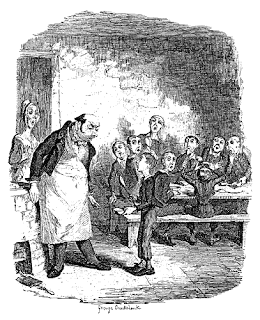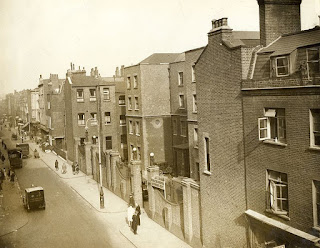El resumen
Oliver
Twist; or, The Parish Boy's Progress, de Charles Dickens,
es una larga novela, con más de 40 capítulos, una cantidad enorme de
personajes, y un argumento lleno de sorpresas.
Aquí un resumen,
primero en castellano y después en inglés. Si quieren un resumen más completo les dejo un link para una página que se especializa
en resúmenes.
También encontramos las palabras workhouse, pickpocket
y
nasty en vocabulario. Y para saber: undertaker
y términos relacionados como: mortician,
dresser, casketing, cossetting y funeral home.
Y como siempre les recomiendo que lean la novela,
que es excelente…
Oliver
Twist es la segunda novela de Charles Dickens publicada en 1838. Un ejemplo temprano de novela social, el libro llama la
atención sobre varios vicios de la edad contemporánea, incluyendo el trabajo de los niños, y su reclutamiento por criminales. Dickens se burla de la hipocresía de la
época rodeando el tema de la novela, muy serio, con sarcasmo y humor negro. La novela puede haber sido inspirada por la
historia de Robert Blincoe
(para leer en inglés en Project Gutenberg), un huérfano cuyos sufrimientos
como niño trabajador en una fábrica
de hilos fue ampliamente conocida en la década de 1830. Es muy probable que la
niñez de Dickens como trabajador
contribuyera al desarrollo de la historia.
La novela fue originalmente publicada en series
mensuales en la revista Bentley´s
Miscellany desde 1837 hasta 1839.
 |
| Oliver asking for more |
Un resumen
Oliver
Twist nace en un orfanato, su madre fallece durante el
parto, y es criado por manos crueles hasta que se lo da en adopción al dueño de
una funeraria. Allí también es maltratado y decide huir a Londres.
Londres
lo recibe con frialdad. Jack Dawkins,
otro niño, le ofrece refugio en la casa de Fagin.
Este hombre instruye a una banda de niños que roban en las calles. Oliver es atrapado y herido. Un señor Brownlow, víctima de los niños, decide
llevara Oliver a su casa para que se
recupere. Le asombra el parecido a un retrato que posee. Oliver es secuestrado por Bill
Sikes y su novia Nancy, y llevado
de vuelta a Fagin.
Fagin
manda
a Oliver a robar a una casa junto a Sikes. Allí es atrapado, pero la dueña
de casa, Mrs. Maylie, y su sobrina, Rose, se encariñan con Oliver. El niño pasa un verano agradable
con esta familia. Los Maylies viajan
a Londres. Nancy informa a Rose de
los planes de Fagin de secuestrar a Oliver. Un miembro de la banda de Fagin escucha la conversación y Bill Sikes, furioso, mata a Nancy.
Mr.
Brownlow descubre que Monks,
uno de los socios de Fagin, es medio
hermano de Oliver. Monks había tratado de asegurarse que Oliver no recibiera herencia alguna.
También se descubre que Rose es
hermana de la madre de Oliver, Agnes
Fleming, y por tanto tía de Oliver.
Fagin es colgado por sus crímenes y Mr. Brownlow adopta a Oliver.
 |
| London workhouse |
Summary
The story begins in a Victorian workhouse. Oliver
Twist is a young orphan. His life in the workhouse is lonely and sad. Oliver becomes an apprentice for an undertaker but runs away after he gets into a
fight with another apprentice.
When Oliver
arrives in London, he meets Jack, who offers him a place to stay.
Unfortunately, Jack and his gang are pickpockets, who work for
a nasty criminal
called Fagin. When Oliver sees the others pick the pocket
of an elderly gentleman, he is horrified and runs away. A man called Mr Brownlow takes Oliver in and looks after him.
Unfortunately, the story does not end there. Fagin and his gang reappear and capture Oliver. They force Oliver to take part in a robbery and he gets shot. A family called
the Maylies nurse Oliver back to health.
Vocabulario
Workhouse:
(in
the UK) a public institution in which
the destitute of a parish received board and lodging in return for work.
Pickpocket:
a
person who steals from people's pockets. Similar:
thief,
bag snatcher, purse-snatcher.
Nasty:
very bad, awful, dreadful.
Para saber
Undertaker:
a
person whose business is preparing dead bodies for burial or cremation and
making arrangements for funerals.
A funeral
director, also known as an undertaker
(British English) or mortician (American English), is a professional involved in the business of
funeral rites. These tasks often entail the embalming
and burial or cremation of the dead, as well as the arrangements for the funeral ceremony (although not the
directing and conducting of the funeral itself unless clergy are not present). Funeral directors may at times be asked
to perform tasks such as dressing (in
garments usually suitable for daily wear), casketing
(placing the corpse in the coffin), and cossetting
(applying any sort of cosmetic or substance to the best viewable areas of the
corpse for the purpose of enhancing its appearance). A funeral director may work at a funeral
home or be an independent employee.
The term mortician
is derived from the Roman word mort- (“death”) + -ician. In 1895, the trade
magazine The Embalmers' Monthly put
out a call for a new name for the profession in the USA to distance itself from the title undertaker, a term that was then perceived to have been tarnished
by its association with death. The term Mortician
was the winning entry.
De la web
Oliver Twist,
Summary from Cliffsnotes.com
Artículos relacionados
En el centro está un caso legal, Jarndyce and Jarndyce, que tiene lugar
porque alguien escribió varios testamentos conflictivos… Bleak House
… cuando es resuelto, al final, los costos legales
han devorado todas las propiedades… Jarndyce and Jarndyce
… era visto como un signo de buena suerte. Se
consideraba que el chico estaba destinado a la grandeza… David Copperfield
Si
te gustó esto compartílo con tus amigos
No hay comentarios:
Publicar un comentario
Deja aquí tus mensajes, comentarios o críticas. Serán bienvenidos